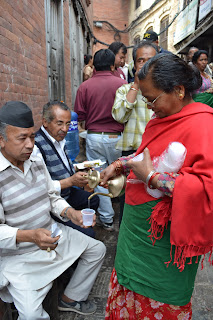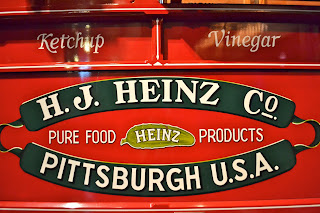Religious Tailgating* at Svayambhunath Stupa
 Svayambunath stupa (or just Svayambhu, pronounced swi-am-boo), is considered one of the most sacred sites in the Kathmandu Valley. Since entire books have been written on its cultural and religious significance to Nepali and Tibetan Buddhists, I'll just briefly sum it up here..and then we'll get to the party.
Svayambunath stupa (or just Svayambhu, pronounced swi-am-boo), is considered one of the most sacred sites in the Kathmandu Valley. Since entire books have been written on its cultural and religious significance to Nepali and Tibetan Buddhists, I'll just briefly sum it up here..and then we'll get to the party.Svayambhu is a religious complex at the top of a hill just outside of the Valley, capped by a large stupa (a large dome topped by a rectangular tower) and features the eyes of the Buddha gazing over the landscape. It's comprised of hundreds of shrines, several temples, and a few monasteries, as well as shops and restaurants. Pilgrims to Svayambhu frequently circumambulate around the base of the stupa, spinning prayer wheels as they go:
 But first, just to get there, you have to climb 365 steps. If you can do so without stopping, it is said you can attain enlightenment in the present lifetime...I admit, KLB and I took some breaks. No enlightenment this go around... Devoted pilgrims make the trek up the hill to Svayambhu on a weekly or even daily basis. It's also a good workout.
But first, just to get there, you have to climb 365 steps. If you can do so without stopping, it is said you can attain enlightenment in the present lifetime...I admit, KLB and I took some breaks. No enlightenment this go around... Devoted pilgrims make the trek up the hill to Svayambhu on a weekly or even daily basis. It's also a good workout.Svayambhu is one of my favorite places in all of Nepal, as there is almost always something interesting happening. Sometimes, it's just monkeys stealing food out of the hands of tourists, other times, it's a giant community religious feast.
This particular visit, KLB and I planned on passing through and taking a few pictures, and perhaps chatting with a few of her friends that live in the Svayambhu complex. However, we arrived to some very large crowds, and after speaking to her friend Deepak, we were informed that we had shown up on the day of the Newar Buddhist community's yearly picnic. We were then informed that we had to return later that afternoon for the actual festivities, but were invited to observe some of the preparations.
In a large open plaza under the watchful eyes of the Buddha, dozens of men and women were chopping vegetables, butchering buffalo and stirring massive, bubbling pots.
In a large open plaza under the watchful eyes of the Buddha, dozens of men and women were chopping vegetables, butchering buffalo and stirring massive, bubbling pots.
 They were peeling and dicing hundreds of pounds of potatoes, chopping stacks of green and red onions, and mincing buckets of garlic. All of this was taking place on the ground, with people seated in groups gossiping, laughing, and generally enjoying the camaraderie.
They were peeling and dicing hundreds of pounds of potatoes, chopping stacks of green and red onions, and mincing buckets of garlic. All of this was taking place on the ground, with people seated in groups gossiping, laughing, and generally enjoying the camaraderie. Deepak led us down a side street, where we found the butchers hacking away at the mortal remains of at least one, if not a couple buffalo:
Deepak led us down a side street, where we found the butchers hacking away at the mortal remains of at least one, if not a couple buffalo: All the while these massive cauldrons of potatoes and buffalo were stewing away, and releasing the most amazing smells. We were able to obtain a few samples during a mid morning break:
All the while these massive cauldrons of potatoes and buffalo were stewing away, and releasing the most amazing smells. We were able to obtain a few samples during a mid morning break: This is choila, grilled buffalo tossed with green onions, chilies, and garlic. It was delicious.
This is choila, grilled buffalo tossed with green onions, chilies, and garlic. It was delicious. We made the "mistake" of lingering just long enough for the crew doing the cooking to start plying KLB and I with some cocktails...like any good tailgate, you have to have something to drink while you're prepping the feast, and in this case, it happened to be chaang and aayla (being poured above). Chaang is a milky-white rice "beer" made in individual homes--it's slightly carbonated and has a somewhat sour taste. Good chaang is pleasant and refreshing (and the stuff they were pouring us was both of those things.) True to the hospitable Nepali nature, our glasses were not even empty before they were refilled.
We made the "mistake" of lingering just long enough for the crew doing the cooking to start plying KLB and I with some cocktails...like any good tailgate, you have to have something to drink while you're prepping the feast, and in this case, it happened to be chaang and aayla (being poured above). Chaang is a milky-white rice "beer" made in individual homes--it's slightly carbonated and has a somewhat sour taste. Good chaang is pleasant and refreshing (and the stuff they were pouring us was both of those things.) True to the hospitable Nepali nature, our glasses were not even empty before they were refilled. Containers of chaang fermenting in a residence.
Aayla is rice "wine," but is probably better described as moonshine. It's very strong, also made at home, and is served in metal ewers. KLB and I had several shots of aayla, as well as a few glasses of chaang--at 10:30 in the morning, mind you--before we were able to bow out and continue on our day with the promise that we would return in the afternoon.
After hitting up the bead markets and the scarf stores, we trekked back up to Svayambhu around 5pm, where the feast was in full swing. Hundreds of people were lined up to receive tikka, the forehead marks given as blessings and frequently made with red pigment, yogurt, and rice.
Those not in line for tikka were seated on the ground in rows, with palm leave plates in front of them, and the assorted cooks/waiters walked down the aisles passing out food and pouring drinks.
Everyone was laughing, chatting, children were running everywhere, and drinks were being liberally poured to all.
 In one corner of the grounds, a band played and chanted, while a woman danced in a trance. According to Deepak, there were probably five thousand people in attendance for the feast, and the food, crowds, smells of burning oil lamps, and noise created a powerful and exciting atmosphere.
In one corner of the grounds, a band played and chanted, while a woman danced in a trance. According to Deepak, there were probably five thousand people in attendance for the feast, and the food, crowds, smells of burning oil lamps, and noise created a powerful and exciting atmosphere.
 Eventually, KLB and I were able to grab a plate of food--sukuti (dried, stir-fried buffalo), amazingly tender stewed buffalo, some phenomenal curried potatoes tossed with loads of garlic and ginger--as well as a few more glasses of chaang, before we finally departed for the evening, stuffed and tipsy. It struck me that even on the opposite side of the world, really, people are fundamentally the same...communities and friendships are marked by the preparation and sharing of food, and of course, the occasional cocktail. The only thing really missing was some football.
Eventually, KLB and I were able to grab a plate of food--sukuti (dried, stir-fried buffalo), amazingly tender stewed buffalo, some phenomenal curried potatoes tossed with loads of garlic and ginger--as well as a few more glasses of chaang, before we finally departed for the evening, stuffed and tipsy. It struck me that even on the opposite side of the world, really, people are fundamentally the same...communities and friendships are marked by the preparation and sharing of food, and of course, the occasional cocktail. The only thing really missing was some football.
 In one corner of the grounds, a band played and chanted, while a woman danced in a trance. According to Deepak, there were probably five thousand people in attendance for the feast, and the food, crowds, smells of burning oil lamps, and noise created a powerful and exciting atmosphere.
In one corner of the grounds, a band played and chanted, while a woman danced in a trance. According to Deepak, there were probably five thousand people in attendance for the feast, and the food, crowds, smells of burning oil lamps, and noise created a powerful and exciting atmosphere. Eventually, KLB and I were able to grab a plate of food--sukuti (dried, stir-fried buffalo), amazingly tender stewed buffalo, some phenomenal curried potatoes tossed with loads of garlic and ginger--as well as a few more glasses of chaang, before we finally departed for the evening, stuffed and tipsy. It struck me that even on the opposite side of the world, really, people are fundamentally the same...communities and friendships are marked by the preparation and sharing of food, and of course, the occasional cocktail. The only thing really missing was some football.
Eventually, KLB and I were able to grab a plate of food--sukuti (dried, stir-fried buffalo), amazingly tender stewed buffalo, some phenomenal curried potatoes tossed with loads of garlic and ginger--as well as a few more glasses of chaang, before we finally departed for the evening, stuffed and tipsy. It struck me that even on the opposite side of the world, really, people are fundamentally the same...communities and friendships are marked by the preparation and sharing of food, and of course, the occasional cocktail. The only thing really missing was some football.








Comments